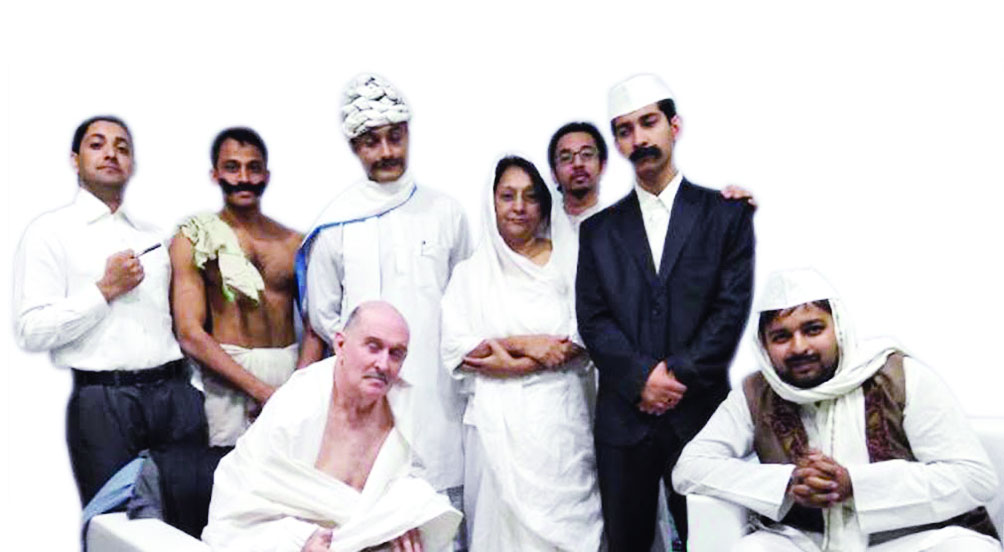Mohan Se Mahatma delved into the transformation of an ordinary man to a saint and his relevance to contemporary India, says Debasrita Chakraborty
The Indian Independence Movement encompassed many ideas, all focused on the common goal to end the British Raj. But it was one man and his journey from an ordinary human being to an almost saint-like status that stood out. Mohan Se Mahatma, the Pierrot’s Troupe’s latest play intends to give the audience a deeper understanding about the transformation. Featuring Tom Alter, Dr. M Sayeed Alam, Yashraj Malik, Manish Singh and others, the play is directed by Alam who has also written the script along with Vibhav Srivastava.
The play starts with three widows clad in spotless white, sitting in a group and discussing in Bhojpuri about Mohan Babu’s stay in South Africa while a soundtrack which comprises of irregular clatter and jangle of iron tracks and the metal wheels of a train plays in the background. Signifying churning and the change, it made the arrival of a Mahatma imminent.
Alam says, “I wanted to re-introduce middle-aged Gandhi as people are not aware of his contributions and achievement during that time. In fact, it was the Champaran Satyagraha movement in Bihar that transformed him and introduced him to rural India.” Alam says Gandhiji realised that the problem of the masses were different from the elites who were heading the freedom movement, and unless the former were involved, it couldn’t be a movement. The Champaran episode played an important role in bringing about this change. Gandhiji knew South Africa, Bombay (now Mumbai), Gujarat but he did not know the rest of India and Champaran brought him face to face with the rest of India. Thus the importance of Champaran, one of the major events of the Indian Independence made Sayeed take it up.
The Champaran Satyagrah movement of 1917, initiated for the Indigo farmers was the first political action led by Gandhiji in India. The movement was for farmers who were being compelled to cultivate indigo on their land as a pre-condition of tenancy. They were being driven to penury because of the low price of indigo.
The message of communal harmony was communicated through a dialogue in the play when Gandhiji says, “When I, a Gujarati Hindu returned to India in 1915, I was welcomed by MA Jinnah, a Gujarati Muslim and I am proud of the fact. In Champaran too, I could not see the difference between Hindus and Muslims. It was this place that made me an Indian.”
In the concluding scene an angry, agitated young boy’s monologue sums up today’s situation.
He says, “Our ire and anger is directed towards you Gandhiji because the English will leave either today or tomorrow but the politicians would still be here. The whites would be replaced by Indians who would rule and they would continue to oppress us. The poor would remain as would diseases and the dirt. These would still be there for 100 years.”
On asking about the relevance of Gandhiji’s relevance in today’s scenario, Alam says, “I think if his philosophy of non-violence is followed almost half of the problem will be solved. let’s protest, lets fight but let’s do everything without using violence, whatever we should do, it should be non-violent.”
The characters in the play portrayed the significant names of the time and the dialogue mapped the language of the specific regions. The entire play is a narration by Gandhiji, portrayed by actor Tom Alter, who sits down to write his biography and recall events in his past. Alam played the role of middle-aged Gandhi, and he says, “I love to play historical characters and have done so many times. Till now I have played Urdu-centric characters but have never played Gandhiji’s character. My age now is almost about the same as Gandhiji when the events depicted in the play took place.”
Another thing that stood out was that in the small space available, the period that had been portrayed was recreated really well.
The sound of the irregular clatter and jangle of the iron tracks and the metal wheels of a train, which initiated the audience’s journey through the Champaran Satyagraha Movement of Bihar also brought it to a close.


























